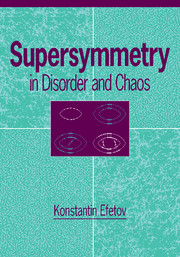Book contents
- Frontmatter
- Contents
- Preface
- Acknowledgments
- 1 Introduction
- 2 Supermathematics
- 3 Diffusion modes
- 4 Nonlinear supermatrix σ-model
- 5 Perturbation theory and renormalization group
- 6 Energy level statistics
- 7 Quantum size effects in small metal particles
- 8 Persistent currents in mesoscopic rings
- 9 Transport through mesoscopic devices
- 10 Universal parametric correlations
- 11 Localization in systems with one-dimensional geometry
- 12 Anderson metal–insulator transition
- 13 Disorder in two dimensions
- 14 Afterword
- Appendix 1 Calculation of the Jacobian
- Appendix 2 Magnetic field parametrization
- Appendix 3 Density–density correlation function at k = 0
- Appendix 4 Effective medium approximation as a saddle point
- References
- Author index
- Subject index
6 - Energy level statistics
Published online by Cambridge University Press: 10 November 2010
- Frontmatter
- Contents
- Preface
- Acknowledgments
- 1 Introduction
- 2 Supermathematics
- 3 Diffusion modes
- 4 Nonlinear supermatrix σ-model
- 5 Perturbation theory and renormalization group
- 6 Energy level statistics
- 7 Quantum size effects in small metal particles
- 8 Persistent currents in mesoscopic rings
- 9 Transport through mesoscopic devices
- 10 Universal parametric correlations
- 11 Localization in systems with one-dimensional geometry
- 12 Anderson metal–insulator transition
- 13 Disorder in two dimensions
- 14 Afterword
- Appendix 1 Calculation of the Jacobian
- Appendix 2 Magnetic field parametrization
- Appendix 3 Density–density correlation function at k = 0
- Appendix 4 Effective medium approximation as a saddle point
- References
- Author index
- Subject index
Summary
Random matrix theory
General formulation
According to the basic principles of quantum mechanics the energy spectrum of a particle in a limited volume is discrete. The positions of the energy levels and the spacings between them depend on the boundary conditions and interactions in the system. In the simplest cases these quantities can be calculated exactly or approximately. However, often the interactions are so complicated that calculations for the levels become impossible. On the other hand, the complexity and variety of interactions lead to the idea of a statistical description in which information about separate levels is neglected and only averaged quantities are studied. Density of states, energy level and wave function correlations, and the like, can be so considered. The analogous approach is used in statistical physics, where information about separate particles is neglected and only averages over large number of particles are calculated.
The idea of statistical description of the energy levels was first proposed by Wigner (1951, 1958) for study of highly excited nuclear levels in complex nuclei. In such nuclei a large number of particles interact in an unknown way and it is plausible to assume that all the interactions are equally probable. Of course, the first question one can ask is what the characterization “equally probable” means and therefore one should introduce a measure for averaging.
- Type
- Chapter
- Information
- Supersymmetry in Disorder and Chaos , pp. 88 - 118Publisher: Cambridge University PressPrint publication year: 1996



